Enjoy the Stunning Autumn Scenery at Popular Spots in Hokkaido

The autumn foliage in Hokkaido is characterized by a mix of green conifers and vibrant red, yellow, green, and orange leaves. The significant temperature difference between day and night enhances the vividness of the colors. In the central Hokkaido area, the Daisetsuzan mountain range offers the earliest autumn foliage in Japan.
Here, we introduce popular autumn foliage spots that showcase various expressions of the region's unique characteristics.
- * Please note that the text shown on this page includes machine translations.
Central Hokkaido (Jozankei, Niseko Annupuri, Lake Toya, Noboribetsu, Hokkaido University)
Sapporo's Hidden Retreat: Jozankei
Known as Sapporo's hidden retreat, Jozankei is a popular hot spring area that can be reached in about an hour from the city center. It's also a famous spot for autumn foliage. Surrounded by mountains, you can enjoy the autumn leaves just by strolling through the hot spring town.
A must-see spot is the Hoheikyo Dam, located about a 15-minute drive from the hot spring town. Many tourists visit to see the combination of the dam's water release and the autumn leaves. The water release is held daily from June to October.
You can also enjoy the beautiful autumn-colored valley by riding a Canadian canoe. The panoramic view of the autumn leaves from the water's surface is breathtaking. You can spend a peaceful and relaxing time with the sound of the river as your background music.
Near Jozankei, the international ski resort operates a "Autumn leaves gondola" during the autumn season. On clear days, you can enjoy a skywalk with views extending as far as Otaru, offering a spectacular autumn landscape.
The Majestic Shape of Mt. Yotei and the Vividly Colored Trees: Niseko Annupuri
From late September, the mountains start to change color, and by early to mid-October, the autumn foliage in Niseko reaches its peak.
By taking the gondola up Niseko Annupuri, you can enjoy the autumn leaves spreading out below, and from the 1,000-meter-high observation deck, you can also admire the majestic shape of Mt. Yotei.
Nearby, "Kagami-numa" and "Shinsen-numa" are also popular spots for autumn foliage. Both have boardwalks around them, and the surrounding primeval forests are reflected on the lake's surface. The vividly colored scenery looks like a painting. Clear, windless days are the best chance to see these reflections. Why not visit while hiking?
Enjoying Autumn Leaves and a Relaxing Time on the Lake: Lake Toya
At Lake Toya, you can enjoy a 360-degree view of the autumn leaves by taking a sightseeing boat. The lakeshore is lined with broad-leaved trees, including rowan and maples, which turn beautiful colors.
Until the end of October, you can also land on "Nakajima," an island floating in the lake. Ezo deer live on Nakajima, so you might see the picturesque combination of deer and autumn leaves, reminiscent of a scene from a classical Japanese poem.
From the Silo Observatory, which offers a panoramic view of Mt. Usu and Showa Shinzan, you can enjoy the spectacular scenery of Nakajima and the entire lake area dyed in red during this season.
During the period until the end of October, you can also enjoy fireworks over the lake. It would be wonderful to relax in a hot spring while enjoying the long autumn nights.
Unique Autumn Leaves of Jigokudani: Noboribetsu
Noboribetsu Onsen is a representative hot spring resort in Hokkaido, boasting nine different types of spring water. The scenic spot "Jigokudani" is the largest source of Noboribetsu Onsen, with a daily output of 10,000 tons. The sight of volcanic gases and high-temperature hot springs erupting, with white steam billowing, truly lives up to the name "Hell Valley." During the autumn foliage season, the contrast between the exposed ground and the colorful trees is striking, offering a unique autumn landscape that can only be seen here.
A short drive away, you can also see beautiful scenery dyed in vivid red at "Oyunuma," where rowan trees and other broad-leaved trees are abundant. There is a natural footbath here, so why not relax and enjoy the surrounding scenery?
The Ginkgo Avenue of Hokkaido University
From late October to early November, the campus of Hokkaido University is adorned with golden ginkgo trees.
The 380-meter-long Ginkgo Avenue, lined with 70 ginkgo trees on both sides of Kita 13-jo Street within the university, looks like a golden tunnel. The fallen leaves spread out like a beautiful carpet, delighting many tourists and locals.
With convenient access, just a 10-minute walk from JR Sapporo Station, it is a must-visit spot when strolling around Sapporo.
Southern Hokkaido (Onuma Quasi-National Park, Kosetsuen)
Delicate Colors Like a Painting: Onuma Quasi-National Park
Onuma Quasi-National Park, centered around Onuma, Konuma, and Junsainuma, is home to rich natural beauty with 126 small islands floating in the lakes. It's a popular spot near Hakodate for enjoying the great outdoors. In autumn, the lakeshore is vividly colored, creating a picturesque scene.
Within the park, there are four walking trails: "Oshima no Michi" along the lakeshore, "Shima Meguri no Michi" and "Mori no Komichi" connecting the islands by bridges, and "Yuuhi no Michi" on the Konuma side. You can fully enjoy the autumn leaves while feeling the refreshing autumn breeze.
Additionally, the "Onuma Lakeside Circular Road" surrounding Onuma is perfect for cycling or driving. It's about 14 km long, so you can complete a loop in about 1.5 hours by bicycle or about 30 minutes by car. Why not enjoy the pleasant feeling of riding through the beautifully colored forests?
The Only Nationally Designated Cultural Property Garden in Hokkaido: Kosetsuen
Kosetsuen is an authentic landscape garden built as a villa for a wealthy merchant during the Meiji era. The garden features a blend of Japanese and Western styles, with a brick greenhouse and a tea house-style pavilion, symbolizing the pioneering spirit of the Meiji era.
The garden, which has around 150 types of trees, is a popular spot for autumn foliage. Many people visit to see the contrast between the valuable cultural property and the red leaves. The 100-meter-long maple avenue is particularly noteworthy.
During the "Hakodate MOMI-G Festival" held from late October to mid-November, the garden is illuminated at night.
Northern Hokkaido (Sounkyo, Ginsendai, Asahidake, Biei)
Enjoying the Rugged Rock Faces and Autumn Leaves: Sounkyo
Sounkyo is characterized by its rugged rock faces with columnar joints that stretch for about 24 km. The area features dynamic gorges and various waterfalls, offering multiple points of interest.
Among them, "Ryusei Falls" and "Ginga Falls," selected as one of Japan's top 100 waterfalls, are perfect viewpoints to enjoy the powerful waterfalls alongside the vibrant autumn leaves. The red and yellow foliage contrasts beautifully with the jagged cliffs, creating a scene reminiscent of a Japanese painting.
Taking the "Kurodake Ropeway" from Sounkyo Onsen to view the autumn leaves is also recommended. The carpet of autumn colors spread out below is breathtaking.
Beautiful Gradation of Mountains: Ginsendai
It's about a 30-minute walk from the trailhead of Mt. Aka-dake. When you reach Ginsendai at an altitude of about 1,500 meters, a breathtaking view of beautifully graded trees spreads out before you.
The trees covering the gentle slopes turn red, yellow, and green, painting the mountainside in stunning colors. Broad-leaved trees like rowan, maple, and birch turn red, yellow, and orange, creating a beautiful gradation with the green of the conifers.
During the peak autumn foliage season, private cars are restricted at Ginsendai, so you can take a shuttle bus to the trailhead. It's a perfect spot for moderate exercise and enjoying spectacular scenery, refreshing both mind and body.
Enjoying Autumn Leaves Even at the Forest Limit: Mt. Asahi
Standing at 2,291 meters, Mt. Asahi is the highest peak in Hokkaido and is often described as a "beautiful peak." You can take a ropeway up to the Sugatami Station at 1,590 meters. From there, a 30-minute trek will bring you to "Sugatami-no-Ike."
Located at the forest limit where tall trees do not grow, this area offers unobstructed views, making it an ideal angle to admire Mt. Asahi. The absence of tall trees allows you to enjoy the autumn colors of low shrubs like Chinguruma and Urajiro-Nanakama.
While climbing to the summit of Mt. Asahi requires full mountaineering gear, the one-hour walking course starting from Sugatami Station is perfect for anyone to easily enjoy the pristine nature and numerous highlights. Why not escape the hustle and bustle of the city and immerse yourself in the great outdoors?
Autumn Foliage in Biei
In spring, the hills of Biei resemble a colorful patchwork, but in autumn, they transform into more subdued hues.
A notable feature is the larch trees, which turn yellow from late October to November, adding a distinctive touch to Biei's landscape. The larch trees on Biei's hills often serve as windbreaks, growing densely and spreading their fluffy yellow foliage charmingly.
At the same time, the season brings the sprouting of autumn-sown wheat, creating a vibrant green carpet on the ground.
The trees turn yellow, the ground is covered with lush green, and in the distance, the snow-capped mountains stand majestically. It’s a unique autumn scenery in Biei, as if summer, autumn, and winter have arrived simultaneously.
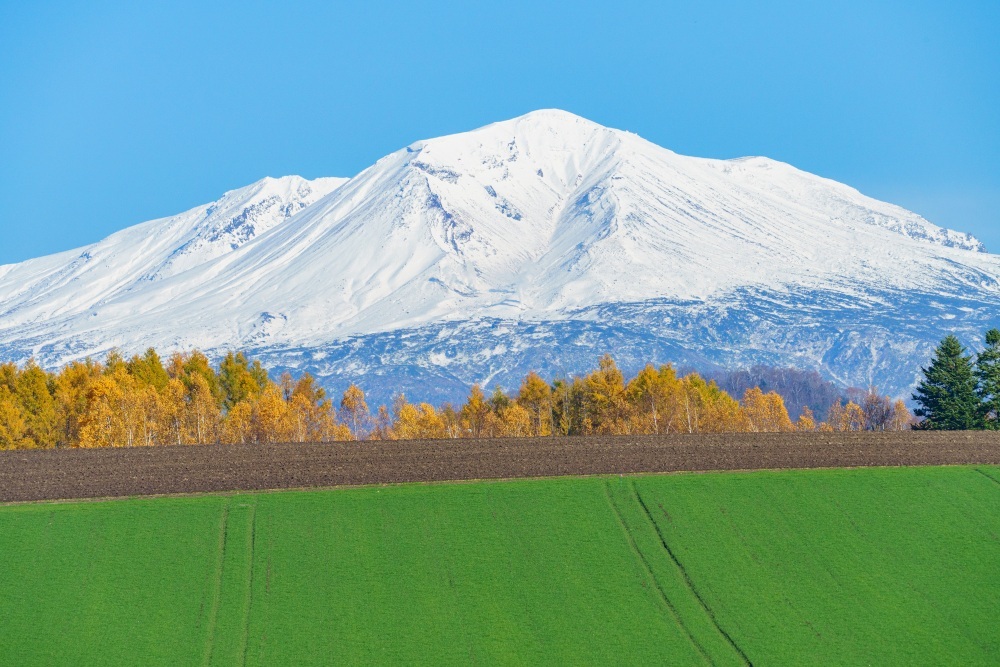
Eastern Hokkaido (Akan Town, Shiretoko, Fukuhara Sanso)
A Lake Dyed in Five Colors: Your Own Spectacular View at Akan-Mashu National Park
Akan-Mashu National Park, which includes lakes such as Lake Akan, Lake Kussharo, and Lake Mashu, is also a famous spot for autumn foliage. The sightseeing boat on Lake Akan, where you can slowly enjoy the autumn leaves from the water, is popular with many tourists.
Among the many attractions in this park, the most recommended spot for autumn foliage is Onneto. Onneto is a mystical lake, considered one of the "Three Great Secret Lakes" among the more than 50 lakes in Hokkaido. Its quiet and secluded atmosphere is perfect for reflecting in the autumn.
The most distinctive feature of Onneto is its color. The surface of the water changes to various colors such as emerald green and cobalt blue, blending with the surrounding autumn leaves to create a very romantic scenery.
Breathtaking Beauty: Shiretoko Pass and Shiretoko Five Lakes
If you want to enjoy the autumn foliage of the World Heritage Site Shiretoko, trekking around the Shiretoko Five Lakes is highly recommended. The lakes, said to be the imprints of the fingers of the gods, possess a mystical beauty. Surrounded by primeval forests, the lakes are backed by the towering Shiretoko mountain range, offering a sense of nature's grandeur. If you time it right, you can enjoy the sight of snow-capped mountains and autumn-colored lakes simultaneously.
The elevated boardwalks along the way allow for a higher vantage point, providing a far-reaching view.
For a scenic drive, "Shiretoko Pass," one of the "Eight Views of Shiretoko," is a must. As you drive along the Shiretoko Transverse Road, the scenery gradually changes as you ascend the pass. With an elevation difference of over 700 meters from the coast to Shiretoko Pass, the autumn foliage descends from the cold summit, allowing you to see the peak foliage somewhere along the way. Near the summit of the pass, there is a parking lot where you can enjoy the majestic view of Mount Rausu.
Autumn Foliage at a Vast Mountain Villa: Fukuhara Mountain Villa (Shikaoi Town)
Located in Shikaoi Town, Fukuhara Mountain Villa is a private villa open to the public only during the autumn foliage season from mid-September to mid-October. It is a popular spot for viewing autumn leaves in the Tokachi area, with a vast area of 85,000 square meters and about 1,000 maple trees planted, captivating visitors with their vibrant colors.
Looking up, you can see the bright red maples against the blue sky, and looking down, you will find fallen leaves spread out like a carpet.
Within the grounds, there are three ponds and five waterfalls, including the "Sculpture Pond" located in front of the villa. The sight of the fiery red trees reflected on the water's surface is a must-see. As you walk along the trails, you can leisurely enjoy the well-maintained gardens and autumn foliage.
Scenic Route 273 from Lake Nukabira to Mikuni Pass
For those who love driving, the Route 273 drive from Sounkyo to Obihiro is highly recommended. This scenic road runs through a vast primeval forest, offering beautiful views throughout the year, but it is especially stunning during the autumn foliage season when the forest turns yellow.
The highlight of the route is the "Matsumi Ohashi" bridge at Mikuni Pass. This approximately 330-meter-long red bridge spans the forest like an ocean, gracefully curving and then descending back into the forest. The red road drawn through the great nature looks like a painting.
At the top of Mikuni Pass, the highest point on Hokkaido's national roads, there is the "Mikuni Pass Cafe," where you can enjoy hand-drip coffee and meals made with locally roasted beans. It's a perfect spot to take a break during your drive. Warm up with delicious coffee and food while enjoying the breathtaking views.
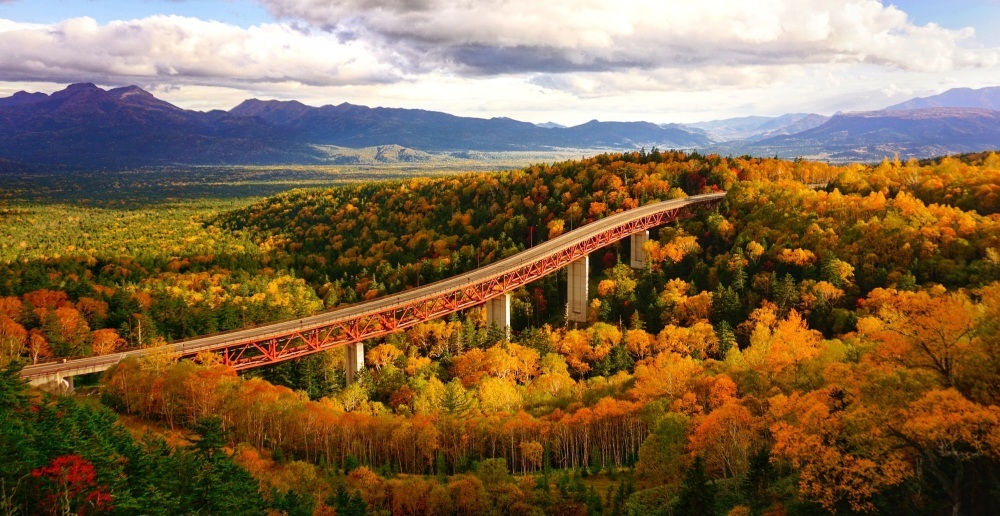
Ranking of popular articles
- Hokkaido Summer Travel Guide
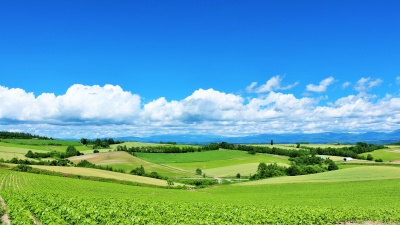
- https://www.visit-hokkaido.jp/en/feature/travelguide_summer
- Hokkaido Spring Travel Guide
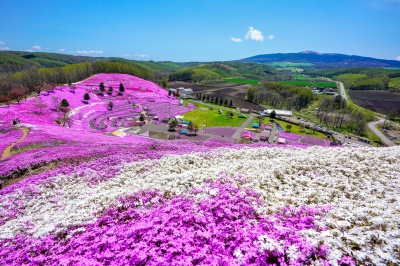
- https://www.visit-hokkaido.jp/en/feature/travelguide_spring
- Here are the recommended cherry blossom viewing spots!
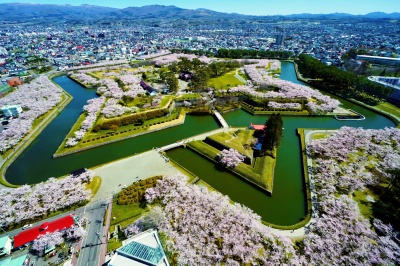
- https://www.visit-hokkaido.jp/en/feature/sakura
- 4 spots to observe red-crowned cranes
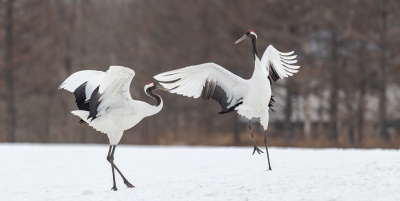
- https://www.visit-hokkaido.jp/en/feature/tancho
- When is the best time to see lavender? Recommended Lavender Spots in Hokkaido
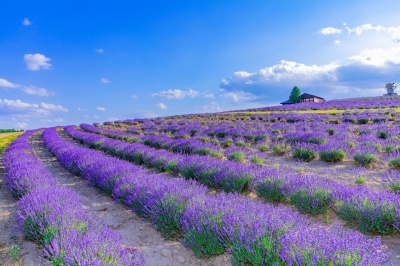
- https://www.visit-hokkaido.jp/en/feature/lavender





































